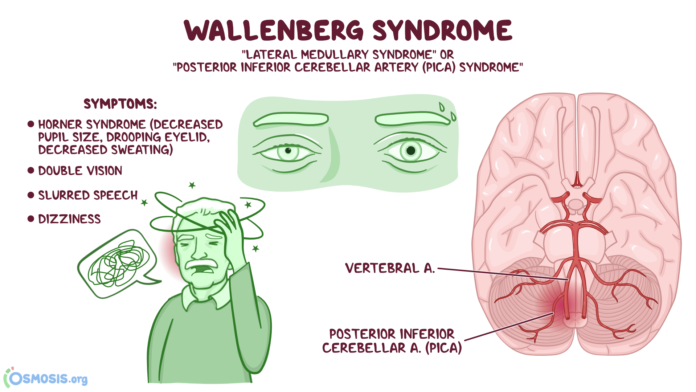Wallenberg syndrome refers to the set of clinical symptoms that result from ischemic injury (for example, a stroke) to a specific area of the brain stem (lateral medulla).
Signs and Symptoms of Wallenberg Syndrome
- Trouble swallowing (dysphagia)
- Feeling hoarse
- Dizziness
- Nausea and vomiting
- Rapid involuntary eye movements (nystagmus)
- Difficulty with balance and gait (walking)
- Problems with body temperature sensation
- Lack of pain and temperature sensation on one side of the face and the other side of the body
- Vertigo
- Hiccups
- Horner syndrome (decreased pupil size, upper eyelid droop, and little or no sweating on one side of the face)
How Is Wallenberg Syndrome Diagnosed?
According to StatPearls, your doctor will likely conduct a physical exam, and may order tests including:
- MRI with diffusion-weighted imaging (DWI) to confirm the location of the stroke
- A CT or MR angiogram (X-ray of blood vessels) to identify the location of the blocked blood vessel and to rule out uncommon causes of stroke
- An ECG to rule out any underlying atrial fibrillation (irregular heartbeat) or acute coronary syndrome (blocked blood supply to the heart)
- Blood tests
Prognosis of Wallenberg Syndrome
In general, however, people with Wallenberg syndrome have better outcomes than people who’ve had other stroke syndromes, per StatPearls. Most recover well; the most common lingering problems tend to be with balance and walking.
Treatment and Medication Options for Wallenberg Syndrome
Treatment for Wallenberg syndrome usually involves managing the symptoms caused by the stroke.
Medication Options
Your doctor may also consider antiemetics to treat persistent nausea and vomiting.
These include:
- Anti-platelet drugs, typically aspirin, which help prevent blood clots. Your doctor might also prescribe Aggrenox, which is a combination of low-dose aspirin and the anti-platelet drug dipyridamole, or aspirin and an anti-platelet drug like clopidogrel (Plavix).
- Anticoagulants, to reduce blood clotting. Heparin may be used short-term; warfarin (Coumadin, Jantoven) may be used for longer periods of time. Newer blood-thinning medications for preventing strokes in high-risk individuals include dabigatran (Pradaxa), rivaroxaban (Xarelto), apixaban (Eliquis), and edoxaban (Savaysa).
Speech and Swallowing Therapies
Prevention of Wallenberg Syndrome
- Control high blood pressure with healthy lifestyle changes and medications.
- Reduce the amount of cholesterol and saturated/trans fat in your diet, which may reduce buildup in your arteries.
- If you use tobacco, quit. Smoking increases the risk of stroke for smokers as well as nonsmokers exposed to secondhand smoke.
- Manage diabetes with diet, exercise, and weight loss or medication if necessary.
- Maintain a healthy weight to prevent stroke risk factors such as high blood pressure, cardiovascular disease, and diabetes.
- Eat five or more daily servings of fruits or vegetables to reduce your risk of stroke. The Mediterranean diet, which is rich in olive oil, fruit, nuts, vegetables, and whole grains, may be beneficial.
- Exercise regularly to lower your blood pressure, increase your levels of good cholesterol, improve the health of your blood vessels and heart, lose or maintain your weight, control diabetes, and reduce stress.
- If you drink alcohol, do so in moderation. Heavy consumption of alcohol raises your risk of high blood pressure and ischemic strokes. On the other hand, small to moderate amounts of alcohol, such as one drink a day, may help prevent ischemic stroke, notes the Mayo Clinic.
- Seek treatment if you suspect you may have obstructive sleep apnea (OSA), a sleep disorder that causes you to stop breathing for short periods while you sleep.
- Avoid illegal drugs, such as cocaine and methamphetamine, which are risk factors for stroke.
- If you’ve already had an ischemic stroke, take prescribed medications to prevent another one.
Research and Statistics: Who Has Wallenberg Syndrome?
Approximately 800,000 people have an acute stroke each year in the United States, notes StatPearls, and 83 percent of these are ischemic strokes. Twenty percent of ischemic strokes occur in the posterior circulation, leading to an estimated 60,000 new cases of Wallenberg syndrome each year.
Many people who have Wallenberg syndrome are men in their sixties.
Related Conditions and Causes of Wallenberg Syndrome
- Trauma to the vertebral artery in the neck
- Inflammation of the wall of the vertebral artery
- Cancer
- Hematoma (swelling of clotted blood)
- Aneurysm (enlargement) of the vertebral artery
- Herpetic brain stem encephalitis (due to herpes)
- Head injury
- Arteriovenous malformations (abnormal tangles of blood vessels)
- Multiple sclerosis
- Varicella (chicken pox) infection
- Brain stem tuberculoma (a rare form of TB)
Resources We Love
American Stroke Association (ASA)
The ASA is a division of the American Heart Association (AHA) that works to prevent, treat, and reduce the incidence of stroke around the world. Learn more about the warning signs of stroke on their website.
National Institute of Neurological Disorders and Stroke (NINDS)
NINDS is a division of the National Institutes of Health (NIH) that researches the brain and nervous system, and conducts work related to Wallenberg syndrome.
Genetic and Rare Disease Information Center (GARD)
Funded by the National Institutes of Health, this site has key information about the symptoms, causes, treatment, and prognosis of Wallenberg syndrome.
Editorial Sources and Fact-Checking
- Wallenberg Syndrome. NIH Genetic and Rare Diseases Information Center. May 22, 2017.
- Wallenberg Syndrome. National Center for Advancing Translation Sciences. May 23, 2017.
- Wallenberg’s Syndrome Information Page. National Institute of Neurological Disorders and Stroke (NINDS). March 27, 2019.
- Wallenberg Syndrome. StatPearls. December 21, 2017.
- Stroke. Mayo Clinic. November 6, 2020.
- Ischemic Stroke (Clots). American Stroke Association.
- Stroke Facts. Centers for Disease Control and Prevention (CDC). September 8, 2020.
- Racial-Ethnic Disparities in Stroke Care: The American Experience. Stroke. May 26, 2011.













































